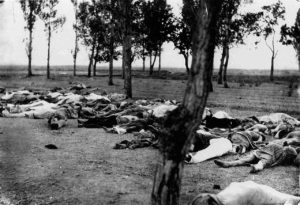
Turkish authorities deny the genocide took place to this day. The Armenian Genocide is acknowledged to have been one of the first modern genocides. According to the research conducted by Arnold J. Toynbee, an estimated 600,000 Armenians died during deportation from 1915–16. This figure, however, accounts for solely the first year of the Genocide and does not take into account those who died or were killed after the report was compiled on 24 May 1916. The International Association of Genocide Scholars places the death toll at “more than a million”. The total number of people killed has been most widely estimated at between 1 and 1.5 million.
Armenia and the Armenian diaspora have been campaigning for official recognition of the events as genocide for over 30 years. These events are traditionally commemorated yearly on 24 April, the Armenian Martyr Day, or the Day of the Armenian Genocide.
First Republic of Armenia:
Although the Russian Caucasus Army of Imperial forces commanded by Nikolai Yudenich and Armenians in volunteer units and Armenian militia led by Andranik Ozanian and Tovmas Nazarbekian succeeded in gaining most of Ottoman Armenia during World War I, their gains were lost with the Bolshevik Revolution of 1917. At the time, Russian-controlled Eastern Armenia, Georgia, and Azerbaijan attempted to bond together in the Transcaucasian Democratic Federative Republic. This federation, however, lasted from only February to May 1918, when all three parties decided to dissolve it. As a result, the Dashnaktsutyun government of Eastern Armenia declared its independence on 28 May as the First Republic of Armenia under the leadership of Aram Manukian.
The First Republic’s short-lived independence was fraught with war, territorial disputes, and a mass influx of refugees from Ottoman Armenia, bringing with them disease and starvation. The Entente Powers, appalled by the actions of the Ottoman government, sought to help the newly founded Armenian state through relief funds and other forms of support.

At the end of the war, the victorious powers sought to divide up the Ottoman Empire. Signed between the Allied and Associated Powers and Ottoman Empire at Sèvres on 10 August 1920, the Treaty of Sèvres promised to maintain the existence of the Armenian republic and to attach the former territories of Ottoman Armenia to it. Because the new borders of Armenia were to be drawn by United States President Woodrow Wilson, Ottoman Armenia was also referred to as “Wilsonian Armenia“. In addition, just days prior, on 5 August 1920, Mihran Damadian of the Armenian National Union, the de facto Armenian administration in Cilicia, declared the independence of Cilicia as an Armenian autonomous republic under French protectorate.
There was even consideration of making Armenia a mandate under the protection of the United States. The treaty, however, was rejected by the Turkish National Movement, and never came into effect. The movement used the treaty as the occasion to declare itself the rightful government of Turkey, replacing the monarchy based in Istanbul with a republic based in Ankara.
